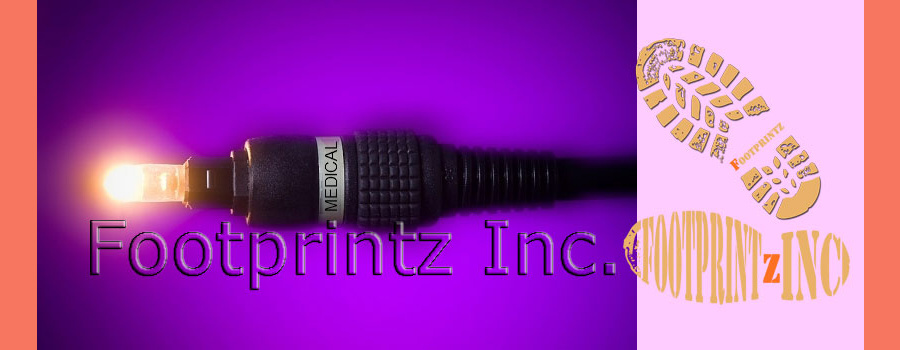
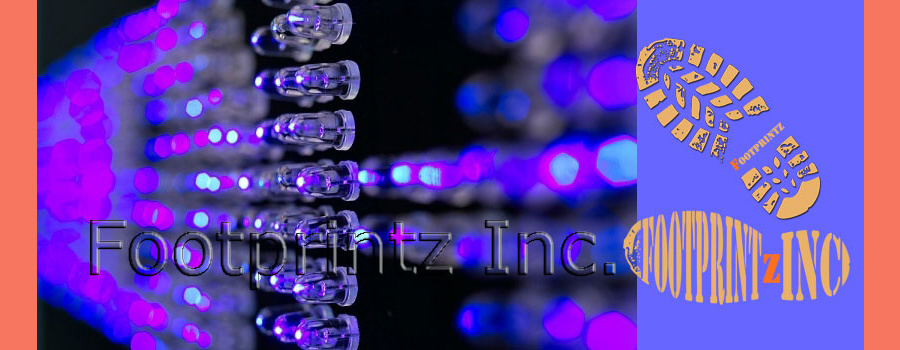

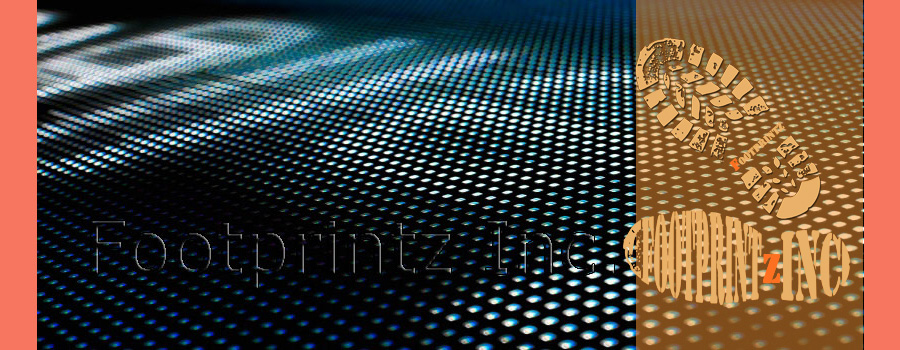
General LED Fundamentals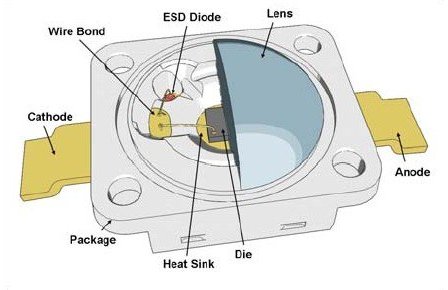
Topic 1: What is an LED?
AN LED IS A LIGHT SOURCE MADE FROM SEMICONDUCTOR MATERIALS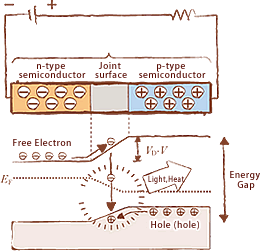
An LED is a light source comprised of a small chip covered with transparent resin. The chip is composed of semiconductor materials, and emits light at the junction/connection area between the materials when current flows through. A semiconductor possesses a conductivity intermediate between a conductors and insulator. When a p-type semiconductor and n-type semiconductor are placed together and voltage is supplied, current flows through the movement of electrons/holes. When an electron meets a hole, it falls into a lower energy state and releases energy, in the form of light (photon).
Topic 2: How is the color of an LED determined?
THE EMITTED COLOR OF AN LED IS DETERMINED BY THE CONSTITUENT ELEMENTS
The types of materials that comprise the LED determine the color within a specific range, based on the resulting energy (band) gap. A wider gap will create shorter wavelengths while a smaller bandgap will produce longer wavelengths. For example, in the diagram below we can see that for an AlGaInP system the emitted color can range from yellow to red and beyond.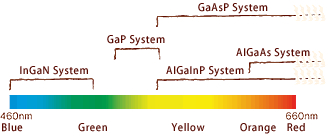
Topic 3: The color of an LED is expressed in units of nm (nanometer).
LIGHT IS A COMPONENT OF ELECTROMAGNETIC RADIATION
Visible light is a part of the electromagnetic spectrum, situated between ultraviolet and infrared rays, and is perceived as color.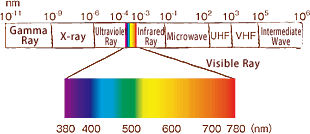
Topic 4: Types and structures of LEDs
TWO TYPES OF LEDS
LEDs are available in 2 basic types, a surface mount chip type and a leaded (through-hole) lamp style. Select the ideal solution based on intensity/brightness, directivity, and mounting constraints.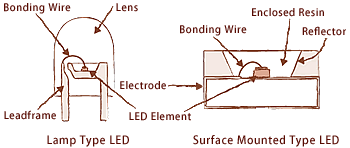
Topic 5: How is an LED made?
THE MAIN COMPONENT IS AN ULTRA-COMPACT CHIP ON THE ORDER OR MICRONS
LED chips are made from a wafer base consisting of SiC (Silicon Carbide) and Al2O3 (Sapphire). This LED element is enclosed with resin together with a bonding wire and electrode.
Topic 6: White LED Structure
THERE ARE 3 MAIN WAYS TO MAKE A WHITE LED
(1) RED LED + GREEN LED + BLUE LED
White light can be emitted using an RGB LED. These units are also currently used in full-color displays since the red, green and blue elements can be used to make a wide range of colors.
(2) NEAR-ULTRAVIOLET LED + RED/GREEN/BLUE FLUORESCENCE
This method uses a near-ultraviolet LED with a short wavelength similar to blue. The three different wavelengths of light resulting from the red, green, and blue phosphorescence creates white light with good color rendering properties.
(3) BLUE LED + YELLOW PHOSPHORESCENCE
This method is the most widely used for lighting. A blue LED and yellow fluorescence are used to make white light, with red and green fluorescence added to maintain color rendering characteristics.
Topic 7: What is the fluorescent substance used for white LEDs?
IT IS NOT POSSIBLE TO MAKE WHITE LEDS WITHOUT FLOURESCENCE
The fluorescent substances are extremely small particles that, when exposed to certain wavelengths, emits visible light. Yellow, green, and red fluorescence are added with a blue or near-ultraviolet LED to emit white light.
Two techniques are used to combine the blue LED and fluorescence:
1) The fluorescence is mixed with the resin and encloses the blue LED
2) The fluorescence is placed directly on the chip itself
Topic 8: Faster than any current light source
Response speed (LED is 20 million times of incandescent light bulb). Response speed (the time when it reaches the brightness of 90% rating after an electric current begins to flow).
20 MILLION TIMES FASTER RESPONSE SPEED THAN INCANDESCENT BULBS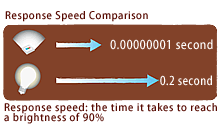
LEDs provide excellent responsiveness, making them ideal for stop lamps in cars that require instantaneous response. LEDs feature a response of 100ns or less, compared to incandescent light bulbs that require anywhere from 0.15 to 0.25 seconds to reach the specified light intensity.
Topic 9: LED light distribution
Broad directivity is possible with LEDs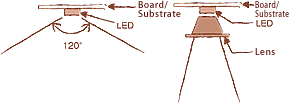
The directivity refers to the change in brightness based on the variation in angle from the central axis. LEDs typically feature strong directivity with narrow light distribution. However, this can be overcome by using a lens, which can widen directivity to 120º.
Topic 10: What is the light emission spectrum?
THIS REFERS TO THE RANGE OF WAVELENGTHS INCLUDED IN LIGHT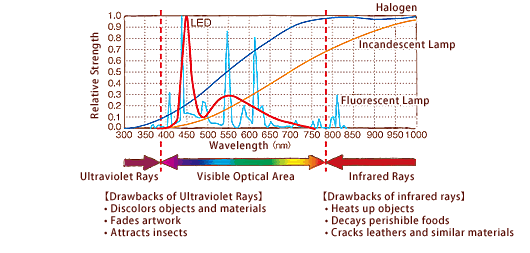
In particular, a Light Emission Spectrum displays the distribution of light intensities in relation to wavelength. Monochrome LEDs show a single peak wavelength based on the color. White LEDs, on the other hand, will show two or more peaks, one for the LED and one for each of the phosphorescent substance used.
Topic 11: What is color rendering?
INCLUDING MULTIPLE COLOR COMPONENTS IS THE KEY TO GOOD COLOR RENDERING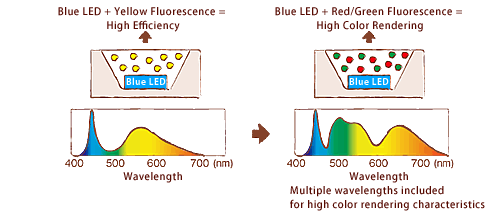
Color rendering is a quantitative index of the ability of a light to faithfully reproduce the true color of an object compared to natural lighting, and is often represented by an index (Color Rendering Index Ra).
A typical blue LED with yellow fluorescence will exhibit an Ra of about 70. However, mixing the blue LED with red and green fluorescence improves color rendering to an Ra=90 or more. However, light emission efficiency will decrease slightly in order to increase light absorption.
Topic 12: Color temperature
THE COLOR TEMPERATURE VARIES BASED ON THE TYPE OF FLUORESCENCE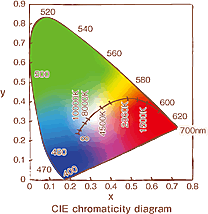
The color temperature is a quantitative value (indicated in Kelvins) derived from the wavelength of light emitted from a blackbody radiator (a hypothetical object that completely absorbs external light) at different temperatures. In general, light at a lower temperature has a reddish tinge while at a high color temperature it appears bluish.
The color temperature of LEDs can be changed by changing the amount and type of fluorescence (in the case of a blue/near-ultraviolet chip).
Topic 13: What is a multichip?
AS ITS NAME IMPLIES, IT CONTAINS MULTIPLE CHIPS
A multichip LED integrates several LED elements into a single package. This is often required for more powerful devices, such as ROHM's 10W LED. Advantages include reduced color variation and a larger surface emitting area.
Topic 14: The importance of heat radiation
A KEY FACTOR IN THE LIFESPAN OF AN LED
The high efficiency of LEDs results in far smaller heat generation than other devices, ensuring longer life while eliminating the need for thermal countermeasures.
Topic 15: Light emission efficiency of LEDs
70% OF POWER SUPPLIED TO AN LED IS CONVERTED TO HEAT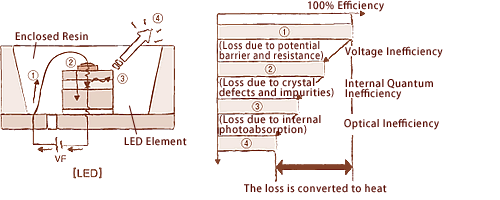
Light emission efficiency indicates the amount of luminous flux (lm) emitted from a light source based on the amount of power (W) used, and is normally given in lumens per watt (lm/W).
Recent white LEDs feature an efficiency of over 100lm/W. Although LEDs are considered high efficiency light sources compared with traditional systems, only around 30% of the supplied power is converted to light. The rest is lost as heat due to voltage, internal (quantum), and optical inefficiencies.
Topic 16: Overall LED efficiency
THERMAL AND POWER SUPPLY DESIGNS ARE THE KEY TO INCREASING EFFICIENCY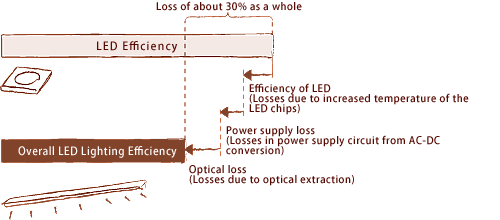
Overall efficiency denotes the amount of efficiency of the entire system, including the power supply, after the total luminous flux is removed from the power consumption. Previous LED systems experienced a decrease in efficiency of 30-50% due to power source losses, thermal generation, and diffusion cover effects. However, overall efficiency has increased due to recent improvements.
Topic 17: Lumen and Lux
Lumens measure the total amount of light output from a particular source. Lux measures the intensity of the light hitting a specified area. For example, an ordinary household lightbulb generates about 1000 lumens, but the intensity of its light at a particular point, such as on a book you're reading, will be comfortably low. Almost all flashlights rely on an optical device such as a reflector or lens to squeeze most of their output into a small area, which allows you to illuminate a point of interest with enough intensity, but without requiring a lot of power. To illustrate this concept, try the following: First, look at your room's ceiling light. In all likelihood, you can stare at it without much discomfort. Now, try looking into a weak flashlight like a traditional incandescent Mini-Maglite. You'll notice that it seems very bright. This is lux. Now, remove your Minimag's head to put it into candle mode. Try switching between its output and your ceiling light's output. Since they're now illuminating approximately the same area, the much higher lumen value of the ceiling light will provide much higher lux values at a chosen point. An extreme example of high lux and low lumens is a laser, which doesn't really create that much light, but focuses it into a tiny, brilliant point.
Topic 18: CCT and CRI
A: CCT stands for "Correlated Color Temperature" and CRI stands for "Color Rendering Index." CCT is expressed in terms of degrees Kelvin, corresponding to the temperature of a black-body radiator (such as the Sun) at that color temperature. For example, a black-body radiator heated to about 8,000 degrees Kelvin would appear slightly bluish, so a light (an MH HID, for example) with a CCT of 8000K would have a bit of a bluish tint to it. CRI is expressed as a number from 1-100 and refers to how well a light source reveals colors regardless of its CCT. For example, a power LED that creates blue light that is filtered through a yellow phosphor to end up with white has no red component, leaving red and yellow objects slightly faded. This will lead to a low CRI rating. Incans, on the other hand, generally have a CRI of around 100, as they emit all spectra of visible light (as well as IR and UV light).